Astronauts all know how important it is to stay healthy in space. Weightlessness alone can cause a number of physiological changes including muscle atrophy, loss of blood volume and bone loss. Most astronauts complete medical training which equips them with the skills to perform procedures such as first aid and basic surgery. But what happens if there’s an emergency and no medical expert to assist?
NASA came up with the answer recently when their teams began putting one of its humanoid robots through medical school. Should a medical incident arise in space that human crew members are unable to deal with themselves, the robo-doc will be there to save the day. Once trained, the robot doctor should be able to complete basic medical procedures unassisted. For more complicated procedures, an earth-based physician could control the robot via telepresence.
After its training is complete, the $2.5 million Robonaut 2, designed to assist astronauts with their duties both inside and outside the International Space Station, will be able to add medical practices to its resume.
Medical training is a complex and lengthy process, even for a robot. Unfortunately there is no super-software that can be uploaded to the robot to make it become an instant medical expert. But one of R2’s instructors, Dr. Zsolt Garami, M.D. says that the robot is a quick learner; in one hour it can pick up as much as it takes human medical student one week to learn.
R2 joined its mechanical twin Robonaut 1 aboard the International Space Station on August 22, 2013. Unlike R1, which is just a head and torso, R2 has been given motorized legs and is much more dexterous. Software may be upgraded in the future to allow R2 to move around the stations interior and perform routine maintenance tasks such as cleaning filters. Other upgrades may enable the robot to work outside the space station to perform repairs and maintenance checks when there is no call for medical assistance.
In the not too distant future, robotic doctors could be beneficial for patients here on earth where they could perform telesurgery in remote areas or where specialist surgeons are not available. It’s also reassuring to know that by the time humans are ready to colonize Mars, Robonaut doctors will be there to lend a healing hand.















